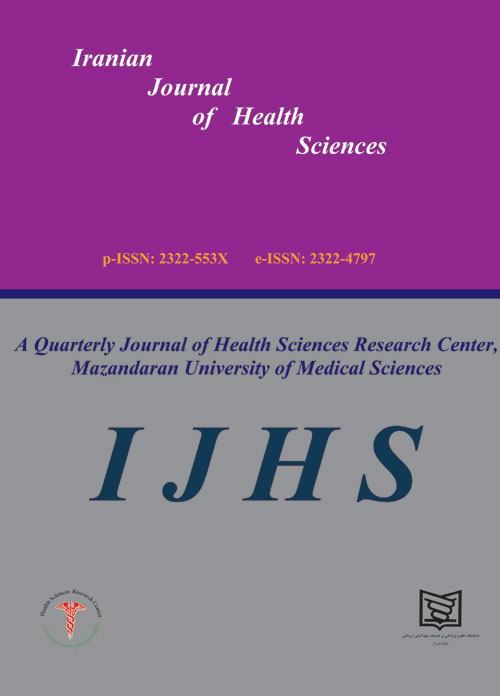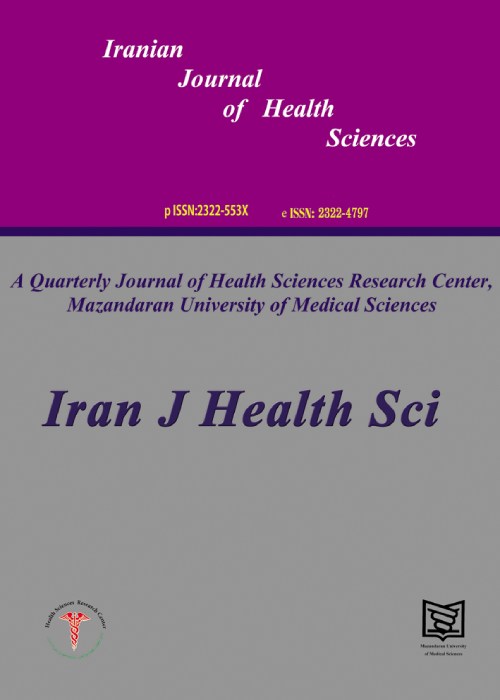فهرست مطالب

Iranian Journal of Health Sciences
Volume:4 Issue: 3, Summer 2016
- تاریخ انتشار: 1395/07/27
- تعداد عناوین: 6
-
-
Pages 1-9Background andPurposeEpicardial fat is the true visceral fat located around the heart, particularly around sub-epicardial coronary arteries that may locally interact and modulate the coronary arteries and myocardium through paracrine or vasocrine secretion of anti-inflammatory and proatherogenic cytokines. Most previous studies have used echocardiography and reported controversial results, probably due to differences in measuring techniques and study population.Materials And MethodsA review of literature was conducted using the PubMed and Google Scholar databases in addition to Google and Yahoo search engines. The purpose was to look for articles describing the association between echocardiographically measured EAT and the major related outcomes including coronary artery disease, left ventricular systolic, diastolic dysfunction, and atrial fibrillation. Finally, 34 articles were included in the results of the present review.ResultThe potential role of echocardiographic epicardial fat thickness as a marker and predictor of cardio metabolic risk has been suggested.ConclusionThe potential role of echocardiographic epicardial fat thickness as a marker and predictor of cardio metabolic risk, metabolic syndrome, excess visceral fat accumulation, insulin resistance, subclinical atherosclerosis, and CAD has been documented in the present study.Keywords: Atherosclerosis, Coronary disease, Echocardiography, Epicardial adipose tissue, Epicardial fat, Obesity
-
Pages 10-21Background andPurposeDiabetes is the most common metabolic disorder which is caused by defects in insulin secretion, insulin action, or both .The most important factor in managing diabetes is self-care. Since diabetes self-care behaviors are multifactorial and these factors may directly or indirectly affect self-care, it is possible through the application of path analysis to estimate the direct, indirect and total effect of variables on self-care.Materials And MethodsThe present study was cross-sectional, and according to the hypothesized model, the sample size was determined to be 500 patients. To collect the study data, five questionnaires were utilized. Path analysis was then conducted to investigate the effects of variables of the study on self-care behaviors. The analyses were performed using SPSS 16.0 and MPlus6 .The following goodness-of-fit were also used: χ2, RMSEA, CFI and SRMR test-statistics. P value 0.1 or less than 0.1 was considered statistically significant.ResultsThe estimated model demonstrated a good model fit, (χ2= 24.5, p=0.22), (RMSEA=0.02), (CFI =0.92) and (SRMR=0.03).Total effect (pConclusionDespite the limitations, each six hypothesized variable leading directly to self-care behavior had significant effect. The study findings indicated that several factors affect self-care behavior which is the most important and most vital step in metabolic control in diabetic patients.Keywords: Self, care, Path analysis, Total effect
-
Pages 22-34Background andPurposeThe heavy metal pollution and its fractionations in the surface sediments of Darreh-Morad Beyg River, Hamedan City were monitored for Cd, Cr, Cu, Fe, Ni, Pb, and Zn in 2014.Materials And MethodsTotally 30 surface sediment samples were taken from 10 stations with three replicates. The samples subjected to bulk digestion and chemical partitioning. The concentrations of heavy metals in sediment were determined by ICP-OES. I-geo, EF, CF, and PLI were also used to assess the sediment contamination.ResultsThe results of the present study showed that the proportions of residual fraction for Cu, Ni, Pb, Cd and especially Cr (93.61%) were relatively high, which implied their lower pollution risks due to low mobility characterization, while Zn was mainly associated with the anthropogenic portion of the existing pollution which meant an increase in mobility for this element. Also, on the basis of the mean, the I-geo values of metals were found in the following order: Cr>Cu>Zn>Ni>Pb>Fe>Cd. At the same time, the average EF of metals in the sediment samples was in the order of Cr>Cu>Zn>Ni>Pb>Fe>Cd. According to the calculated PLI, the pollution class of heavy metals in sediments from the Darreh-Morad Beyg River was between 1 and 2, indicating a moderately polluted degree.ConclusionRegarding the high Zn concentrations in sediments, it is likely that this element is a major hazard for the aquatic environment since it is mainly found in the anthropogenic portion. Also, Cu, Ni, Pb, Cd, and Cr are present in the greatest percentages in the residual fraction, which implies that these metals are strongly linked to the sediments.Keywords: Heavy Metals, I, geo, Surface Sediment, Sequential Extraction, Darreh, Morad Beyg River
-
Pages 35-44Background andPurposeSince protein A is considered an important protein from medical, medicinal, genetic engineering, and biotechnology point of view, the present study attempted to investigate and determine to what extent protein A is produced through regression, in addition to the production conditions of the protein. Thus, a figure was introduced as for the estimation of the amount of protein A.MethodsWith the introduction of fuzzy mathematics and its combination with statistical methods, the kinds of regression models for estimating the amount of unknown variables were introduced. The utilization of fuzzy regression was developed from 1982 through the introduction of regression models, and the fuzzy data was based on a kind of linear plan. One of these regression models is fuzzy regression which considers the features of fuzzy numbers and the estimation obtained through them, and it has a higher level of reliability.ResultsIn the present study, fuzzy regression method was introduced, and the number usage of this model in estimating the amount of secretion of protein A was investigated. It was then confirmed that this estimation method had a higher level of reliability. The type of regression used in this article was fuzzy regression that had a higher confidence level than the point classic regression. At the same time, the number of triangular fuzzy number was used in the current research in terms of computational handling, and it was found that triangular fuzzy number was much easier to use in comparison with the other species.ConclusionSecretion and extracellular production of recombinant protein is a wide production method which is currently developing. In the present study, it was observed that the statistical methods for improving the process in medical biotechnology are ideal methods. It was also documented that for laboratory designing of this important protein and achieving the best and most improved conditions for production and secretion, its amount of production must first be calculated through statistical methods.Keywords: protein A, extracellular, fuzzy groups, triangular fuzzy numbers, fuzzy regression
-
Pages 45-53Background andPurposeOccular toxicity is one of the most important complications of Hydroxychloroquine. Not any type of treatment has so far been found and recommended for this disorder. The purpose of this study was to report some characteristics of patients with Hydroxychloroquine Induced Retinopathy.Materials And MethodsFrom 107 patients with rheumatoid arthritis (RA) and/or systemic lupus erythematosus (SLE) during 2013-14 in Sari, Iran, who were selected by a simple sampling method and were referred to hospitals for ophthalmologic examinations, 21 patients were found with HCQ induced retinopathy. The Examination for HCQ-induced maculopathy was performed through fundoscopy, perimetry or optical coherence tomography (OCT), and the physicians had their own discretion based on the examination. Although the patients were examined by different ophthalmologists, all of them were evaluated by the same device (Zeiss cirrus HD OCT4000.USA for OCT, Zeiss Humphrey Field analyzer 2i. USA for visual field, and Topcon. TRC.50Dx. Japan for angiography). Based on the collected data, the characteristics of clinical and ophthalmologic changes were reported, and the data were analysed through Independent Sample t Test and χ2.Results21 patients (19 females) with a mean age of 49.86 (±15.6) were evaluated during 4.95 (±4.7) years of therapy. The mean of cumulative dose was calculated to be 313.18±269.8 grams. Based on the findings, hypertension was detected in 5 (23.8%) of the patients.ConclusionIn the present study, it was found that HCQ induced retinal toxicity may occur even in recommended doses or for less than 5 years. Other risk factors such as hypertension in addition to the dose or duration of toxicity could also accelerate retinal toxicity.Keywords: Hydroxychloroquine, Antimalarial agents, Retinal toxicity
-
Pages 54-64Background andPurposeThe survival rate of gastric cancer patients has significantly increased during the last decades because of the advances in this type of cancer treatment. The purpose of the current study was to examine the survival levels of gastric cancer through Weibull regression and its affective causes.Materials And MethodsIn this research, the records and personal information of 643 patients who were evolved by gastric cancer and referred to Imam Khomeini hospital of Sari (2007- 2013) were studied in order to determine their levels of survival. During the study, 74 cases of patients were exempted from the study due to their defective data, and the data collected from 569 cases were analyzed to obtain the results. In the current study, the impact of factors affecting Survival time was determined using the Weibull regression model. The analysis of data was performed using Stata statistical Software in 0.05 significance level.ResultsThe findings of the study showed that these patients were estimated to experience 5 years of survival probability equal to 0.75, 0.68, 0.54, 0.41, 0.3 during the time period November December, 2013, the 1, 2, 3, 4 with a median survival time equal to 19 months, resulting in a survival mean equal to 24.49 months. Based on the Univariate and Multivariate analyses methods, some variables like: stage and metastasis were determined as the affective factors on the survival probability. (p-valueConclusionIn this study, it was then concluded that the life span of examined patients is very low in comparison with developed countries, which might be because of late reference or delayed diagnosis and the lack of facilities for treatment. Thus, the factors such as earlier diagnosis of the problem and screen methods could certainly influence and increase the patient's survival rate.Keywords: Gastric cancer, Survival analysis, Weibull regression


